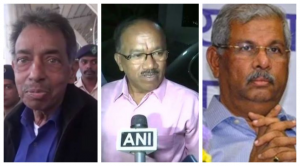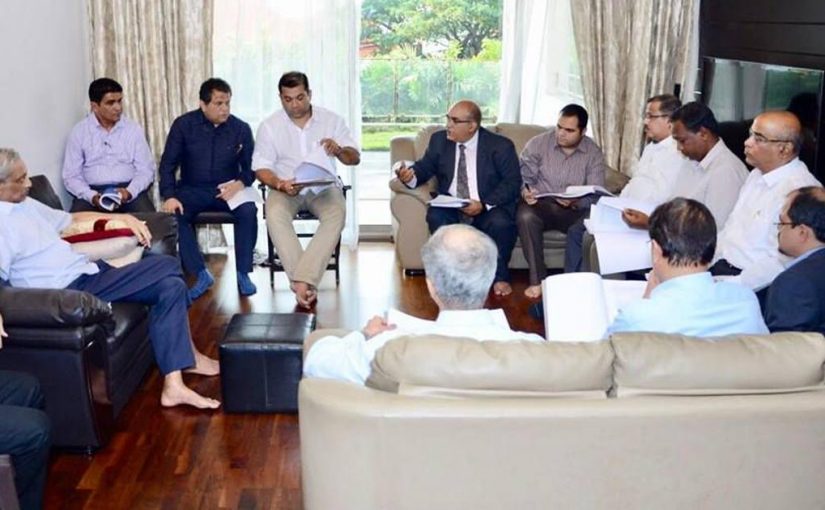HEADLESS: For over eight months the state of Goa has had a sick chief minister who has been absent from the state only making brief visits from New York and Delhi. No one knows the state of his health and he is not willing to give up power. The only glimpse given was of his ostensibly chairing an IPB meet but people speculate the photo was staged
BY RAJAN NARAYAN
Goan Observer was started as an independent media organization in November 2003 when the BJP was in power under Chief Minister Manohar Parrikar. Fifteen years down the line, Parrikar, who had put on the mask of a secular, liberal leader, has become a monster. A monster who has turned against his own friends like Francis D’Sousa and Laxmikant Parsekar and many others like the veteran BJP leader Dr Wilfred Mesquita. For ten months Parrikar left the state headless while he was in hospital in New York, Delhi and a specially designed ‘hospital’ in Taleigao. In the absence of any oversight, mining barons have been replaced by the huge real estate mafia who have destroyed all the hills and are now demolishing the Kadamba plateau. On our 15th anniversary we dedicate ourselves to the restoration of good governance and maintaining the green Goa we knew for the benefit of our children
Our journey began on November 1, 2003, when we set up our office at Tropicana Apartments in La Campala Colony. The online edition of the Goan Observer had been started even earlier — on October 1. I had decided by then to quit the OHeraldo after 20 years of transforming the Portuguese daily, whose circulation had dropped drastically, into a full-fledged English daily.
I had come to Goa on the invitation of the late Mario Miranda the famous cartoonist. I was attracted by the challenge of starting an English newspaper from scratch, although in retrospect I wonder if I made a mistake. If I had remained in Bombay, where I spent 15 years of my media career, perhaps I would have been better off health wise and wealth wise. This is because Goa is like Mars as far as the rest of the country is concerned.
The national media may love to come to Goa for a holiday. In fact M J Akbar, who recently quit as Minister of State for External Affairs, was a frequent visitor to Goa, with or without girl-friends. But even if you break a nationally important story from Goa like the court verdict on Sanatan Sanstha nobody takes notice. There has been no governance in Goa with a chief minister with pancreatic cancer and yet the rest of the country could not be bothered about the headless wonder called Goa.
That apart I quit the Herald because the father AC Fernandes who had invited me had died and his greedy son Raul Fernandes had taken over. While AC Fernandes was not interested in making money of the paper and had the guts to stand up to Pratapsingh Rane, the son was, and is, only interested in money. I quit because the BJP had come to power and Raul was

harassing me to get a casino license. I told him I was a journalist not a pimp. I kept him in suspense over when I would hand him my resignation. I even brought out a few dummy copies of the Goan Observer with the help of Jonquil Sudhir, my only employee when I started. I kept getting threatening calls from the then general manager of the Herald, Promod Revonkar, who is now the general manager of the Navhind Times.
I was determined to set the stage to start an independent media organisation before I quit the Herald. Moreover I wanted to leave the Herald on the 20th anniversary of my joining the Herald which was October 10, 2003. There was a tradition of holding a mass on the anniversary of the Herald. It used to be presided over by the same priest, Fr Oscar Quadros. I handed over my resignation letter not to Raul Fernandes but to the priest, Fr Oscar Quadros.
More than a month before we started the Goan Observer we had started a fund raising campaign. I had a meeting of the few friends at the International Centre. I also made a public appeal for help and was very pleasantly surprised by the generosity not of the big industrialists, but the small people. Literally hundreds of ordinary citizens contributed amounts ranging from `1,000 to `10,000 for the launch of the Goan Observer. There were of course some close friends who contributed between `10,000 and `25,000 each.
We had not been able to attract any major investor when we started at 2003. All that we had by way of equipment was one-and-a-half computers. The half because it was borrowed from a good friend, CS Mirchandami, for a few days. The chairs and tables were donated by the late Norman D Souza of Sun Village. The bulk of the initial share capital was contributed by the better three-quarters Tara Narayan who put in the `2 lakhs that she had saved. After working for Herald for 20 years I got a gratuity of `90,000. I remember Shriniwas Dempo being shocked to learn that I used to get a salary of only `10,000 per month as the editor of the Herald. The gratuity was calculated at the rate of 15 days salary for every year of service. It did not take into account that I have made the owners of the Herald not only rich but among the most powerful families in Goa.
Fortunately for me, a former colleague from the Herald, Melanie Sequeira, who had joined me as a secretary but went on to become my magazine editor, insisted on coming along and helping me to set up the paper free of cost. After she left the Herald, Melanie became the news editor of the Gomantak Times. The only woman news editor. Our covers, layout and design were again done at no cost free of charge by Shamir Diniz.
We launched the Goan Observer on November 15, 2003, at the Mandovi Riviera in the presence of a few friends.
EARLY DAYS
We soon realized we needed someone to look after advertising and distribution. That is how Gustav Fernandes, former general manager of the Herald, joined us. Along with him came a good friend of one of our first promoters Allan Pinto, whose cousin Reginald Dias joined us as financial consultant and has remained with us even though he knows the ship is sinking. Our first full time layout artist was Deepak Chari, who was later joined by Pravina and subsequently Bindiya Vaval. Our most long standing marketing ustad was Sanjeev Naik. Suresh Nagvekar, who joined us as a driver, went on to become our distribution manager.
We were very clear right from the beginning that Goan Observer should not be dependent either on government advertisements or on private advertisements which had strings attached to it. We were very clear in our mind that we would not sell ourselves for 40 pieces of silver — as many newspapers have started to do, led by the TOI. We continued to explore other sources of revenue.
We were fortunate enough to get the support of some prominent NRI Goans. Eddie Fernandes who was a close friend of one of our first directors, Floriano Lobo, gave us his flat to use as an office at a nominal rate. Subsequently, when he visited Goa, he gave us a large donation.
Desktop publishing contributed significantly to the revenues of the Goan Observer. A Canadian NRI, Ben Antao, entered into a contract with us for publishing all his books. He also allowed us to keep the revenue from the sales of his books, except for copies that he wanted for himself and for his friends. This was a beginning of our desktop publishing ventures. We published half a dozen novels of Ben Antao.
We were approached by Mario Sequeira of Tonia Distillery to publish his book on how he gave up smoking. We not only published the book titled ‘Killing Me Softly’ but also persuaded the then education minister to buy 500 copies.
One of our then directors, Arvind Bhatikar, wanted us to publish an English version of his wife, Snehalata’s, very popular Marathi book on caring for children. We published it under the title ‘Mothering and Smothering’. Fortunately, we had been granted ISBN numbers which we still have and could project ourselves as an authorized publisher. An ISBN number which appears on the back of the book is like a digital signature. It is unique to every book and particularly useful to booksellers, libraries, book wholesalers and distributors.
Besides desktop publishing we also accepted commissions to research and write books. Dattaraj Salgaocar of Goa Publications whose father V M Salgaocar had played a major role in the Opinion Poll asked us to write a book on a sale. After a lot of extensive research by the late Dr Sharon Cruz the book was released by the then Union Minister for Culture. The greatest compliment we received was that the book was like a research thesis which covered every aspect of the Opinion Poll.
The government of Goa under the chief ministership of Digambar Kamat was kind enough to entrust us with a responsibility of bringing out a book on the history of Goa’s Liberation. Working closely with Prashant Loliekar and other freedom-fighters like Nagesh Karmali, we were able to bring out an outstanding book which is available even in the US Library of Commerce. We also helped with the autobiography of the former chairmen of the SBI, PG Kakodkar. Other creative ventures like posters on swine flu and dengue used to ensure that the cash flow of Goan Observer was not affected. At our peak we were employing 15 people, paying them salaries comparable or above the daily newspapers.
TROUBLED TIMES
The bad times came with the arrival in Goa of the TOI. The salaries of journalists are decided not by the managements, but by the National Wage Board. The scales and working conditions are determined on the bases of the turnover of the media organizations. Since the joint turnover of the TOI was considered it was required to pay a minimum salary of almost `40,000 even at the starting of the scale. This was more than what even chief reporters and news editors got from Goan newspapers before the Times came to Goa. As a matter of policy the TOI also hires the best or the most talented journalists whether they need them or not. Although only three pages of TOI are produced in Goa, they have more than a dozen reporters each making about a lakh.
Other newspapers like the Navhind Times, which was owned by the mining lobby, and Herald, which by than had made a lot of

money, could compete with the TOI. As a weekly we couldn’t, and lost three of our best reporters, including Gauree Malkarnekar who has emerged as one of the best reporters in the country.
The achhe din of Narendra Modi became the start of our bure din. When the BJP came to power at the Centre we stopped getting government advertisements. Even when we got them we were not paid for months. Even at the time of writing, various government departments owe us more than `2 lakhs. They owe us much more but we have written off dues which are pending more than a year.
Ever since the Modi government came to power we have not got any book contracts from the Department of Culture. The worst part is that all our old industrial friends, with the exception of very few, virtually stopped advertising with us. Because I knew them at a personal level they all used to help us generously before the BJP came to power at the Centre.
It became worse when the BJP stole the Goa government after the 2017 election. But we continue to fight to stay alive with the help of a few friends. When the cash flow gets choked up I shell out from my nominal savings.
We have requested our friends and admirers to at least advertise in our anniversary issues in November. We hope they will do it as we believe that if we manage to survive till the next election we will makeover for the better. We are confident that the BJP will lose heavily in the elections to the five states for which results will be announced on December 4. And we are convinced that BJP will not come back to power in Delhi and Goa. The best hope of making this happen is to continue to support the GO team.
